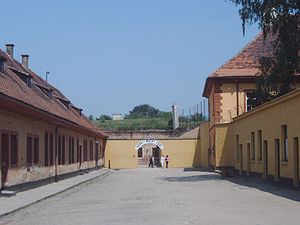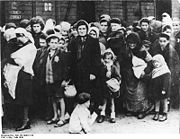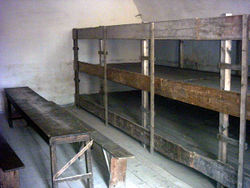- Theresienstadt concentration camp
-
"Theresienstadt" redirects here. For the town, see Terezín.
Coordinates: 50°30′48″N 14°10′1″E / 50.51333°N 14.16694°E
 Location of the concentration camp in the Czech Republic
Location of the concentration camp in the Czech Republic Gate with the slogan "Work Brings Freedom" in the Small Fortress
Gate with the slogan "Work Brings Freedom" in the Small Fortress
Theresienstadt concentration camp (often referred to as Terezín) was a Nazi German ghetto during World War II. It was established by the Gestapo in the fortress and garrison city of Terezín (German name Theresienstadt), located in what is now the Czech Republic.
Contents
History
The fortress of Terezín was constructed between the years 1780 and 1790 by the orders of the Austrian emperor Joseph II in the north-west region of Bohemia. It was designed to be a component of a projected but never fully realized fort system of the monarchy, another piece being the fort of Josefov. Terezín took its name from the mother of the emperor, Maria Theresa of Austria who reigned as empress of Austria in her own right from 1740–1780. By the end of the 18th century, the facility was obsolete as a fort; in the 19th century, the fort was used to accommodate military and political prisoners.
From 1914 till 1918 it housed one of its most famous prisoners: Gavrilo Princip. Princip assassinated Archduke Franz Ferdinand of Austria and his wife on June 28, 1914, which led to the outbreak of the First World War. Princip died in cell number 1 from tuberculosis on April 28, 1918.
On June 10, 1940, the Gestapo took control of Terezín and set up the prison in the Small Fortress (kleine Festung), see below. By November 24, 1941, the Main Fortress (große Festung, i.e. the walled town of Theresienstadt) was turned into a ghetto.[1] To outsiders, it was presented by the Nazis as a model Jewish settlement, but in reality it was a concentration camp 'where over 33,000 inmates died as a result of hunger, sickness, or the sadistic treatment meted out by their captors'.[2] Theresienstadt was also used as a transit camp for European Jews en route to Auschwitz. 'Although some survivors claim the population reached 75,000, official records place the highest figure on September 18, 1942, at 58,491 in Kasernes (barracks) designed to accommodate 7,000 combat troups.'[3]
Dr. Siegfried Seidl, an SS-Hauptsturmführer,[4] served as the first camp commandant in 1941. Seidl oversaw the labor of 342 Jewish artisans and carpenters, known as the Aufbaukommando, who converted the fortress into a concentration camp. Although the Aufbaukommando were promised that they and their families would be spared transport, eventually all were transported to Auschwitz-Birkenau in September 1944[5] for Sonderbehandlung, or "special treatment", i.e. immediate gassing of all upon arrival. Seidl himself was hanged for his crimes by a post-war tribunal in Vienna in 1946.[6]
As in other European ghettos, a Jewish Council nominally governed the ghetto. In Theresienstadt this was known as the "Cultural Council" and eventually known by the residents as the "Jewish self-government of Theresienstadt".[7] The first of the Jewish Elders of Theresienstadt was Jakob Edelstein, a Polish-born Zionist and former head of the Prague Jewish community. In 1943, he was deported to Auschwitz, where he was shot to death after watching his wife and son being shot to death also.[8] The second was Paul Eppstein, a sociologist originally from Mannheim, Germany. Earlier, Eppstein was the speaker of the Reichsvereinigung der Juden in Deutschland, the central organization of Jews in Nazi Germany. In the course of the liquidation transports in autumn 1944, when some two thirds of the ghetto population were deported to Auschwitz, Eppstein was allegedly shot in the Small Fortress.[citation needed] He died on Yom Kippur, the holiest day in the Hebrew calendar, after he informed the deported people of what was awaiting them in the "East". Benjamin Murmelstein, a Lvov-born Vienna Rabbi, succeeded Eppstein. In the last days of the ghetto's existence, Jiří Vogel of Prague served as the Elder. In addition, Leo Baeck was between 1943 to 1945 the speaker of the Council of Elders of Theresienstadt, after being deported from Berlin, where he had served as the head of the Reichsvereinigung der Juden in Deutschland. He was to survive Theresienstadt and emigrated to London after the war. [9]
Amongst those who died in Terezine was Alice Archenhold the wife of the astronomer Friedrich Simon Archenhold and their daughter Hilde. Having sold valuables to pay to travel to Terezin did not prevent her from being forced to live in overcrowded barracks and sleeping 3 to a bunk bed. Among those who were incarcerated there but survived, was Czech Olympic water polo competitor Kurt Epstein.
Many of the 80,000 Czech Jews who died in the Holocaust died in Theresienstadt, where the conditions were extremely difficult. In a space previously inhabited by 7,000 Czechs, now over 50,000 Jews were gathered. Food was scarce and in 1942 almost 16,000 people died, including Esther Adolphine (a sister of Sigmund Freud), who died on September 29, 1942; Friedrich Münzer (a German classicist), who died on October 20, 1942. Medicine and tobacco were strictly prohibited; possession could be punished by hard labor or death. Single men and women were officially forbidden to meet, or to communicate with a Gentile without German permission, however married couples often remained together and were able to sleep in the same quarters.[7]
It soon became the "home" for a great number of Jews from occupied Czechoslovakia. The 7,000 non-Jewish Czechs living in Terezín were expelled by the Nazis in the spring of 1942. As a consequence, the Jewish community became a closed environment.
Command and control authority
The camp was established under the order of the SS-Reichssicherheitshauptamt (RSHA) in 1941. The administration of the main camp was under the authority of the SS-Wirtschafts-Verwaltungshauptamt (WVHA), to which answered the SS officers and soldiers who oversaw camp administration, themselves members of the SS Concentration Camp service, or the Totenkopfverbande (SS-TV). Security within the camp was provided by guard battalions of the SS-TV and police battalion troops of the Ordnungspolizei. An internal police force, run by the Jewish inmates themselves, was known as the Ordnungsdienst and answered directly to the SS. The camp also made use of Czech Gendarmerie guards.
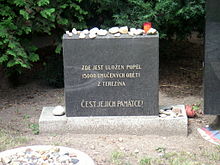 Stone marking the burial of ashes of 15,000 victims of Terezín at the New Jewish Cemetery, Prague
Stone marking the burial of ashes of 15,000 victims of Terezín at the New Jewish Cemetery, Prague
By 1943, the Concentration Camp service of the SS had been completely folded into the Waffen-SS, with most of the camp staff and guards serving as reserve Waffen-SS soldiers. The Gestapo also maintained a presence at the camp, in that it was the Gestapo and Sicherheitsdienst which oversaw the day-to-day operations in the "Small Fortress" prison. The direct command authority for the camp itself was the Inspector of Concentration Camps, to which the Commandant reported to directly, yet the camp also received orders from the RSHA (specifically Department IV-B4 under Adolf Eichmann), the Office of the Protectorate of Bohemia and Moravia (under Reinhard Heydrich), and the office of the local SS and Police Leader.
During the camp's existence, three officers served as Camp Commandant: Siegfried Seidl, Anton Burger, and Karl Rahm.
Differing living conditions for prisoners
In the spring of 1945, the inhabitants of Theresienstadt were screened by the Gestapo, who made a classification that took note of prominent individuals. These 150 – 200 prominent individuals were given usually a single room for just two people, so that a husband and wife could live by themselves. Several of these were members of the Cultural Council, who were included among the Prominente, due to the influence of Benjamin Murmurstein, who was himself already classified as "prominent" as the "Jewish Elder" of Theresienstadt. It is inferred in statements from ex-prisoners that there were often issues with nepotism and protection of individuals by those who held positions of authority over the others, as they struggled to avoid deportation and death.[7]
Theresienstadt supplied the German war effort with a source of Jewish slave labor. Their major contribution was the splitting of mica mined from local Czechoslovakia. Blind prisoners were often spared deportation by assignment to this task. Others manufactured boxes or coffins. Others sprayed military uniforms with a white dye to provide camouflage for German soldiers on the Russian front. According to ex-prisoners, Theresienstadt was also a sorting and re-distribution centre for underwear and clothing confiscated from Jews.. "from all parts of Germany, the baggage taken away from the Jews was sent to Theresienstadt, and there it was packaged, sorted-out in order to be sent out all over the country, to various cities, for the people who were bombed-out and suffered a shortage of underwear and clothing."[7]
456 Jews from Denmark were sent to Theresienstadt in 1943. These were Jews who had not escaped to Sweden before the arrival of the Nazis. Included also in the transports were some of the European Jewish children whom Danish organizations had been attempting to conceal in foster homes. The arrival of the Danes is of great significance, as the Danes insisted on the Red Cross having access to the ghetto. This was a rare move, given that most European governments did not insist on their fellow Jewish citizens being treated according to some fundamental principles. The Danish king, Christian X, later secured the release of the Danish internees on April 15, 1945. The White Buses, in cooperation with the Danish Red Cross, collected the 413 who had survived.
On February 5, 1945, the SS chief Heinrich Himmler allowed a transport of 1,210 Jews from Theresienstadt, most of them originating from the Netherlands, to Switzerland. According to an agreement between Himmler and Jean-Marie Musy, a pro-Nazi former Swiss president, the group was released after $1.25 million was placed in Swiss banks by Jewish organizations working in Switzerland.
On May 1, 1945, control of the camp was transferred from the Germans to the Red Cross. A week later, on May 8, 1945, Terezín was liberated by Soviet troops.
After the victory of the Allies in 1945, Theresienstadt was used by Czech partisans and former inmates to hold German SS personnel and civilians as retaliation for their atrocities.[citation needed] After the German surrender the small fortress was used as an internment camp for ethnic Germans.[citation needed] The first prisoners arrived on the May 10, 1945. On February 29, 1948 the last German prisoners were released and the camp was officially closed. Among the interned Germans were former Nazis like Heinrich Jöckel, the former commander of Terezín and other SS members.[citation needed]
After the Allied victory and lasting until July 1945 the mortality rate in the camp was high due to diseases, malnutrition and incidents of murder.[citation needed] Commander of the camp in that period was Stanislav Franc.[citation needed]
In July 1945 the camp shifted under the control of the Czechoslovak Ministry of Interior. The new commander appointed was Otakar Kálal. From 1946 on the inmates were gradually transferred to Germany and Terezín more and more turned into a hub for the forced migration of Germans from the Czech lands into Germany proper.[citation needed]
A small exhibition currently commemorates the history of Terezín as internment camp for Germans.
Cultural activity of inmates
Theresienstadt was originally designated to be seen to house privileged Jews from Germany, Czechoslovakia, and Austria. Many educated Jews were inmates of Theresienstadt, and the camp was publicized by the Nazis for its rich cultural life: "We had . . . During the early period there were no (musical) instruments whatsoever, and the cultural life came to develop itself only when the . . . when the whole management of Theresienstadt was steered into an organized course.".[7] At least four concert orchestras existed in the camp, as well as chamber groups and jazz ensembles. Several stage performances were produced and attended by camp inmates. Many prominent artists from Czechoslovakia, Austria, and Germany were imprisoned there. There were artists, writers, scientists, jurists, diplomats, musicians, and scholars.
The community in Theresienstadt tried to ensure that all the children who passed through continued with their education. Though the Nazis decreed that all camp children over a certain age must be gainfully employed, working on stage was considered employment, and the children's education often continued under the guise of work or cultural activity. Daily classes and sports activities were held and the magazine Vedem was edited there. This affected some 15,000 children, of whom only about 1,100 survived to the end of the war. Other estimates place the number of the surviving children as low as 100.
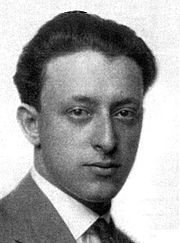 Czech composer Rafael Schächter
Czech composer Rafael Schächter
The camp served as a place of internment for conductor Rafael Schächter, who formed a chorus within the camp and gave a performance of the massive and complex Requiem by Giuseppe Verdi. Schächter would go on to conduct 13 more performances of the work within the chorus before his eventual deportation to Auschwitz-Birkenau.
Julius Stwertka, violinist and a former leading member of the Boston Symphony Orchestra and co-leader of the Vienna Philharmonic Orchestra perished in the camp on December 17, 1942.
Martin Roman and Coco Schumann were part of the "Ghetto Swingers" jazz band.
Artist and art teacher Friedl Dicker-Brandeis created drawing classes for children in the ghetto. This activity resulted in the production of over four thousands children's drawings, which Dicker-Brandeis hid in two suitcases before being sent to Auschwitz. This collection was thus preserved from destruction by the Nazis and was not discovered until a decade later. Most of these drawings can now be seen at The Jewish Museum in Prague, whose Archive of the Holocaust section is responsible for the administration of the Terezin Archive Collection. The children of the camp also wrote stories and poems, some of which were preserved and later published in a collection called I Never Saw Another Butterfly.
Painter Malva Schalek (Malvina Schalkova) was deported to Theresienstadt in February 1942. She produced more than 100 drawings and watercolors portraying life in the camp. Because of her refusal to portray a collaborationist doctor, she was deported to Auschwitz (May 18, 1944), where she perished.[10]
The composer Viktor Ullmann was interned in September 1942 and died at Auschwitz in October 1944. He composed some twenty works at Theresienstadt, including the one-act opera, Der Kaiser von Atlantis (The Emperor of Atlantis or The Refusal of Death), first performed in 1975, shown in full on BBC television in Britain, and still performed today. It was to be performed in the camp, but permission was withdrawn when it was in rehearsal, probably because the authorities perceived its allegorical intent. Another composer who died in Theresienstadt was Zikmund Schul.
Inmates at the concentration camp composed the music on Terezín: The Music 1941-44, a 2-CD set released in 1991.[11][12] It contains chamber music by Gideon Klein, Viktor Ullmann, and Hans Krása, the children's opera Brundibár by Krása, and songs by Ullmann and Pavel Haas. All the composers died in the Auschwitz concentration camp in 1944, except for Klein, who died the following year in Fürstengrube. Many of the works were written at the end of their lives, in 1943 and 1944.[13]
Canadian musician Ruth Fazal has composed Oratorio Terezin, a full-length production scored for orchestra, children's choir, adult choir, and three vocal soloists. The oratorio is based on children's poetry from Terezin combined with passages from the Hebrew scriptures. It premiered in Toronto in November 2003, and subsequently visited concert halls in Prague, Brno, Vienna and Bratislava during March 2004. In May 2005 a tour of Israel included Tel Aviv, Jerusalem and Karmiel, and it was the main cultural event of Holocaust Memorial Day in Tel Aviv on May 5, 2005. The US premiere took place in February 2007 at the Tilles Centre on Long Island, and at Carnegie Hall, New York City.[14]
In 2007, the Swedish singer Anne Sofie von Otter released a well-reviewed CD of music composed in Theresienstadt, assisted by baritone Christian Gerhaher, pianists and chamber musicians. In 2008 Austrian baritone Wolfgang Holzmair, and American pianist Russell Ryan, presented an intense Theresienstadt recital that drew on a different selection of songs, causing Washington Post critic Anne Midgette to comment on the wealth of material available; when the recital was issued on a CD in 2009 reviewers praised its artistic merit.
Improvements implemented by inmates
Ex-prisoner Friedrich Schlaefrig describes how the residents with the assistance of the Germans, overcame the lack of water to the town; "We had no water system in Theresienstadt... a number of wells were contaminated in a short time with typhoid fever. That was the reason that we had to close a number of wells, and had to undertake to extend the existing water pipe system. That was really a great piece of public works created under Jewish inventiveness and by Jewish labor. They expanded the water supply system, and have achieved [a condition] that we not only produced for the people good drinking water or, at least, not objectionable drinking water, but that also the toilet installations could be flushed with water, so that these unhygienic conditions were removed... The Germans have permitted it, and we even obtained through them the material, because otherwise it would have been impossible..."[7]
After this a Fire Department with an acting Fire Chief was established from the Jewish residents using the newly created water system.
Used as propaganda tool
Main article: Theresienstadt (film)On June 23, 1944, the Nazis permitted a visit by representatives from the Danish Red Cross and the International Red Cross in order to dispel rumors about the extermination camps. The commission included E. Juel-Henningsen, the head physician at the Danish Ministry of Health, and Franz Hvass, the top civil servant at the Danish Foreign Ministry. Dr. Paul Eppstein was instructed by the SS to appear in the role of the mayor of Theresienstadt.[15]
To minimize the appearance of overcrowding in Theresienstadt, the Nazis deported many Jews to Auschwitz. Also deported in these actions were most of the Czechoslovakian workers assigned to 'Operation Embellishment.' They also erected fake shops and cafés to imply that the Jews lived in relative comfort.
The Danes whom the Red Cross visited lived in freshly painted rooms, not more than three in a room. These could possibly have included the homes of the "prominent" Jews of Theresienstadt who were afforded special privileges whereby as little as two people shared a single room.[7] The guests enjoyed the performance of a children's opera, Brundibar, which was written by inmate Hans Krása.
Apparently the Red Cross representatives were easily fooled by the Germans as the tour was conducted by following a pre-determined path designated by a "red line" on a map. The hapless Red Cross apparently didn't attempt to divert from the "official" tour route as led by the Germans who also posed questions to the Jewish residents along the way. If the Red Cross attempted to ask the residents questions directly, they were ignored and not answered. Despite this, the Red Cross still apparently formed a positive impression of the town.[7]
The hoax against the Red Cross was apparently so successful for the Nazis that they went on to make a propaganda film at Theresienstadt. Production of the film began on February 26, 1944. Directed by Jewish prisoner Kurt Gerron (a director, cabaret performer, and actor who appeared with Marlene Dietrich in The Blue Angel), it was meant to show how well the Jews lived under the "benevolent" protection of the Third Reich.
Instead the film, if taken on face value, positively documents the Jews of Theresienstadt living a relatively comfortable existence within a thriving cultural centre, functioning successfully during the hardships of World War II. This is perhaps puzzling considering the circumstances in which the film was made, by Jewish "residents" themselves. However, as they were all prisoners acutely aware of their fate should they step out of line, and considering that anything they made would certainly be screened and edited by their Nazi overseers, there was little they could do but comply.
After the shooting of the film, most of the cast and even the filmmaker himself were eventually deported to Auschwitz. Gerron and his wife were murdered by gas chamber on October 28, 1944.[citation needed] The film was not released at the time, but was edited into pieces and only segments of it have remained.
Often called The Führer Gives a Village to the Jews, the correct name of the film is: Theresienstadt. Ein Dokumentarfilm aus dem jüdischen Siedlungsgebiet (Terezin: A Documentary Film of the Jewish Resettlement). (Cf. Hans Sode-Madsen: The Perfect Deception. The Danish Jews and Theresienstadt 1940–1945. Leo Baeck Yearbook, 1993)
Juan Mayorga, the award-winning Spanish playwright, wrote his play Way To Heaven (Himmelweg) inspired by the visit of the Red Cross to Theresienstadt. The play has been produced world-wide, including London, Paris, Madrid, Buenos Aires and, most recently, New York and Sydney. In October 2011, the Odyssey Theatre Ensemble in Los Angeles, California under the direction of Ron Sossi has staged another performance headlined by Norbert Weisser who previously performed in Schindler's List (movie).
Statistics
 10 Kronen — money that is claimed to be part of the propaganda presented to the Red Cross committee. In fact, despite the claims that these were just papers without any real value and were never used, ex-residents of Theresienstadt describe how they each received 50 crowns every month free with which to buy things.[16]
10 Kronen — money that is claimed to be part of the propaganda presented to the Red Cross committee. In fact, despite the claims that these were just papers without any real value and were never used, ex-residents of Theresienstadt describe how they each received 50 crowns every month free with which to buy things.[16]Residents working at the camp were also paid in this currency,[7] a form of truck system.
Approximately 144,000 Jews were sent to Theresienstadt. Most inmates were Czech Jews. Some 40,000 originated from Germany, 15,000 from Austria, 5,000 from the Netherlands and 300 from Luxembourg. In addition to the group of approx. 500 Jews from Denmark, also Slovak and Hungarian Jews were deported to the ghetto. Some 1,600 Jewish children from Białystok, Poland, were deported to Auschwitz from Theresienstadt; none survived. About a quarter of the inmates (33,000) died in Theresienstadt, mostly because of the deadly conditions (hunger, stress, and disease, especially the typhus epidemic at the very end of war). About 88,000 were deported to Auschwitz and other extermination camps. At the end of the war, there were a mere 17,247 survivors. 15,000 children lived in the camp's children's home; only 93 survived.
Small Fortress
Small Fortress (Malá pevnost in Czech, Kleine Festung in German) was part of the fortification on the left side of river Ohře. Beginning in 1940, the Gestapo used it as a prison (the largest one in the Protectorate of Bohemia and Moravia). It was separate and unrelated to the Jewish ghetto in the main fortress on the river's right side. Around 32,000 people arrived there and were usually sent to a concentration camp later. 2,600 people were executed, starved, or succumbed to disease there.
Of the 15,000 children sent there, a possible 1,100 survived. Anton Malloth was a notorious prison guard at Small Fortress who was convicted of beating at least 100 prisoners to death, and was sentenced to life imprisonment in 2001, after escaping justice for 55 years.
The Small Fortress was also used as a prison for Allied prisoners of war who had persisted in escaping from POW camps.
For many years the Australian and New Zealand governments denied that any of their servicemen had been sent to Terezin, but after several years of campaigns the Australian Prime Minister Bob Hawke established a committee of investigation in 1987 which eventually ordered $10,000 compensation payments to the surviving veterans. Australian journalist Paul Rea produced the 1985 film Where Death Wears a Smile which made sensational allegations about the supposed murder of dozens of Allied prisoners at Terezin. These claims have been refuted by one of the veterans, Alexander McClelland, in his book The Answer – Justice.[17]
Films about Theresienstadt
Documentaries:
- A Story about a Bad Dream
- Paradise Camp
- Prisoner of Paradise
- Voices of the Children
Movies:
- The Last Butterfly
- War and Remembrance (TV miniseries)
References
- ^ "Theresienstadt". Holocaust Encyclopedia. United States Holocaust Memorial Museum. http://www.ushmm.org/wlc/en/article.php?ModuleId=10005424. Retrieved September 1, 2010.
- ^ p.155, in Staging the Holocaust: The Shoah in Drama and Performance, by Claude Schumacher (1998) Cambridge University Press
- ^ The Terezin Diary of Gonda Redlichby Saul S. Friedman (ed.) and Laurence Kutler (transl.), with a foreword by Nora Levin (1992) University Press of Kentucky
- ^ Shoa.de – Theresienstadt – einige wichtige Tatsachen[dead link]
- ^ Footnote with further references on p.1 in The Terezin Diary of Gonda Redlich by Saul S. Friedman (ed.) and Laurence Kutler (transl.), with a foreword by Nora Levin (1992) University Press of Kentucky
- ^ Footnote 24, p.6 inThe Terezin Diary of Gonda Redlichby Saul S. Friedman (ed.) and Laurence Kutler (transl.), with a foreword by Nora Levin (1992) University Press of Kentucky
- ^ a b c d e f g h i "David P. Boder Interviews Friedrich Schlaefrig", Voices of the Holocaust Project (Paris, France: voices.iit.edu), August 23,1946, http://voices.iit.edu/interview?doc=schlaefrigF&display=schlaefrigF_en, retrieved September 1, 2010
- ^ Friedländer, Saul (2009). Nazi Germany and the Jews: The Years of Persecution, 1933–1939. HarperCollins. p. 410. ISBN 9780061350276. http://books.google.com/books?id=rEnDts1bJ2kC&printsec=frontcover&dq=nazi+germany+and+the+jews&hl=en&ei=Oh-ITZfjOMfogQeg7JDJDQ&sa=X&oi=book_result&ct=result&resnum=1&ved=0CC8Q6AEwAA#v=onepage&q=jakob%20edelstein&f=false.
- ^ Days of Sorrow and Pain, Leo Baeck and the Berlin Jews, by Leonard Baker, Oxford University Press, 1978, Pulizter Prize winner
- ^ A few of the paintings Schalek did at Theresienstadt can be seen at this web site.
- ^ Campbell, R.M. (November 11, 1999). "Holocaust Musicians Left Powerful Legacy(Review)". Seattle Post-Intelligencer (Seattle, WA). http://www.highbeam.com/doc/1G1-64111685.html. Retrieved September 1, 2010.
- ^ Stearns, David Patrick (January 28, 1995). "Testament of Terezin". The Independent (London). http://www.highbeam.com/doc/1P2-4697092.html. Retrieved September 1, 2010.
- ^ "Terezín – The Music 1941–44". Ciao. cd.ciao.co.uk. http://cd.ciao.co.uk/Productinformation/Terez_iacute_n_The_Music_1941_44__6161678. Retrieved September 1, 2010.
- ^ Oratorio Terezin website
- ^ Theresienstadt: Red Cross Visit
- ^ "David P. Boder Interviews Hildegarde Franz", Voices of the Holocaust Project (Munich, Germany: voices.iit.edu), September 20, 1946, http://voices.iit.edu/interview?doc=franzH&display=franzH_en, retrieved September 1, 2010
- ^ McClelland, Alexander (1998). The Answer- Justice. Uckfield, East Sussex UK: Historical Review Press. ISBN 9780906879412.
Further reading
- Adler, H.G.Die Verheimlichte Wahrheit, Theresienstaedter Dokumente,Tübingen: Mohr 1958)
- Adler, H.G. Theresienstadt, 1941–1945; das Antlitz einer Zwangsgemeinschaft. Geschichte, Soziologie, Psychologie. Tübingen, Mohr, 1960.
- Bondy, Ruth. "Elder of the Jews":Jakob Edelstein of Theresienstadt, translated from the Hebrew 1989, ISBN 0-8021-1007-X'
- Drexler, Paul In Search of My Father: The Journey of a Child Holocaust Survivor, ISBN 9780980518511
- Feuss, Axel. Das Theresienstadt-Konvolut, Hamburg 2002, ISBN 3-935549-22-9
- Friesova, Jana Renee. Fortress of My Youth: Memoir of a Terezín Survivor ISBN 0-299-17810-2
- Green, Gerald. The Artists of Terezin, New York: Hawthorn Books 1959.
- Karas, Joza. Music in Terezin, 1941–1945, Pendragon Press, 1990, ISBN 0-918728-34-7
- Klíma, Ivan. "A Childhood in Terezin", Granta 44 (1993).
- Polak, Monique. "What World is Left" Orca book publishers, U.S.A 2008, ISBN 978-1-55143-847-4
- Makarova, Elena. University over the Abyss Lectures in Ghetto Theresienstadt, Sergei Makarov & Victor Kuperman, ISBN 965-424-049-1
- Herbert Thomas Mandl. Tracks to Terezín (Interview: Herbert Gantschacher; Camera: Robert Schabus; Edit: Erich Heyduck / DVD; Arbos, Vienna-Salzburg-Klagenfurt 2007)
- Milotova, Jaroslave and Anna Hajkova, eds. Theresienstädter Studien und Dokumente, 1994–present (yearbook), online at the CEEOL database. [1]
- Oppenhejm, Melanie. Theresienstadt: Survival in Hell, ISBN 1-8743-2028-4
- Rea, Paul. Voices from the Fortress ISBN 978-0-7333-2095-8
- Redlich, Gonda. The Terezin Diary of Gonda Redlich ISBN 0-8131-1804-2
- Schiff, Vera. Theresienstadt: The Town the Nazis Gave to the Jews, [2]
- Schwertfeger, Ruth. Women of Theresienstadt, Oxford, Berg 1989.
- Sebald, W.G. Austerlitz.
- Volavkova, Hana, ed. ...I never saw another butterfly...:Children's Drawings and Poems from Terezin Concentration Camp 1942–1944, Schocken Books, 1993.
- Manes, Philipp. As If It Were Life (A WWII Diary From the Theresienstadt Ghetto), Germany 2009, ISBN 978-0-230-61328-7
External links
- Theresienstadt – About the Holocaust – Yad Vashem
- Music and the Jewish Holocaust: Theresienstadt – The Model Camp, by Dr. Guido Fackler
- Way To Heaven (Himmelweg), Critically acclaimed play by Juan Mayorga, based on the events that took place at Theresienstadt.
- Beit Terezin, Theresienstadt Martyr's Remembrance Association at kibbutz Givat Haim Ihud, Israel
- Terezín Initiative Institute
- Tours of the Ghetto and Small Fortress
- The Archive of Holocaust at The Jewish Museum in Prague
- Terezín Chamber Music Foundation
- Terezin memorial at Find-A-Grave
- Theresienstadt Money
- Pastimes: Numismatics
- The Genocide of the Czech Jews by Miroslav Karny
Wikimedia Foundation. 2010.

